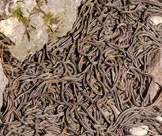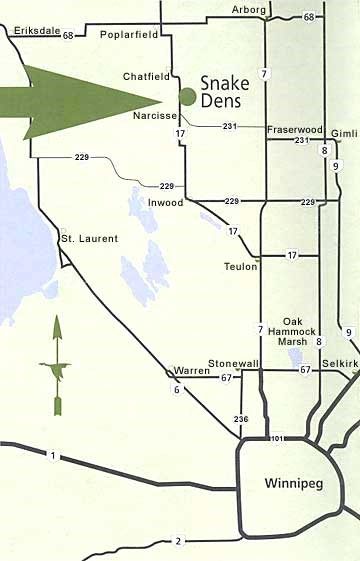Snakes of Narcisse
Snakes of Narcisse Update
October 9, 2025:
The fall snake viewing season at the Narcisse snake dens is coming to an end. Most of the snakes are now headed underground to their winter habitat. Please check back in early May for updates on the spring emergence.
Every spring, the Narcisse Snake Dens are alive with tens of thousands of red-sided garter snakes as they slither to the surface from their winter dens. These snakes are ready to begin their annual mating ritual. This spectacular ritual lasts for a one to three week period in late April or early May, depending on weather conditions. The male snakes are usually first to surface and they wait patiently for the females to come out. As the larger females surface, the male snakes are eager to mate with them.
 This eagerness is displayed in a "mating ball" where one female is surrounded by up to one hundred males. There are four active snake dens at the Narcisse Snake Dens. The dens are connected by a 3.0 kilometre self-guiding interpretive trail. Although the garter snakes are harmless, they are best viewed from the observation platforms built next to the dens.
This eagerness is displayed in a "mating ball" where one female is surrounded by up to one hundred males. There are four active snake dens at the Narcisse Snake Dens. The dens are connected by a 3.0 kilometre self-guiding interpretive trail. Although the garter snakes are harmless, they are best viewed from the observation platforms built next to the dens.
Best Viewing Times
The activity level of the snake dens is posted every few days during the spring and fall. Check the status when planning your trip to Narcisse.
Spring: The latter part of April and first three weeks in May is generally the best time to visit the Narcisse Snake Dens. During this period snakes are preoccupied with mating and are easily viewed by visitors. The greatest activity tends to coincide with the Mother's Day weekend.
Fall: Garter snakes return to their dens in early September. Once there, they remain active and visible to visitors until cool, wet autumn weather forces them underground. Fall viewing of snakes is best during warm sunny days.
Where to Find
Where to Find the Snakes of Narcisse
Look for the Narcisse Snake Dens sign on Highway #17, 6 kilometres (3.6 miles) north of Narcisse (GPS coordinates of 50o44’07.62” N and 97o31’54.32” W). Turn east at the entrance sign and follow the short road to the parking lot. Here you will find orientation and interpretation signs, washrooms, a picnic area and a 3.0 kilometre (1.8 mile) walking trail. The trail winds through native grassland and aspen forest, and is easy to follow. It’s a good idea to bring refreshments and a lunch as there is no food or beverage service on site.
Visitors coming from Winnipeg should allow approximately 1.5 hours to drive the 130 kilometre (80 mile) trip to Narcisse Wildlife Management Area Location Map (see below).
Access
Please park in the main lot. Only authorized vehicles operated by Manitoba Natural Resources and Indigenous Futures staff are allowed beyond the parking lot.
Access into the dens and adjacent buffer zones is prohibited for both the safety of visitors and the well-being of the snakes. Viewing platforms at each den site provide a convenient location of watching the action.

Nearby Services
Gas stations, general stores and restaurants are located along Provincial Trunk 17 Highway in the communities of Teulon, Inwood and Poplarfield once you turn off Highway #7.
What to Bring
It's always a good idea to have a cap and windbreaker with you. The trails are covered with crushed limestone, so comfortable hiking boots or a sturdy pair of running shoes are all you need.
You may wish to bring your own beverages and a light snack. As you will likely spend anywhere from one to two hours in the area, and cover a fair bit of ground, chances are you'll work up a thirst and an appetite. Be sure to bring a camera and a pair of binoculars for close up snake viewing and bird watching.
Other Places to Visit
A treasure chest of historical, recreational and educational experiences awaits casual travelers and intrepid explorers who venture into Manitoba's Interlake region. Among the gems in the chest are the Oak Hammock Marsh Interpretive Centre, Marine Museum of Manitoba (Selkirk) Inc., Lower Fort Garry, Captain Kennedy House and the other attractions along Red River Road, Hecla Island Provincial Park and Stonewall Quarry Interpretive Centre. Be sure to visit the snake statue in Inwood north of Highway 17.
FAQs
- Can we pick up snakes?
- How can you tell the sex of a snake?
- Why are there so many snakes in the Interlake area?
- Do snakes use the same den year after year?
1. Q:Can we pick up snakes?
A: Yes. Garter snakes are not poisonous. We encourage you to only handle a snake in the presence of the site interpretive staff. They can show you how to handle a snake properly so that these fragile creatures are less likely to be harmed. Snakes of any sex can be handled in the fall, but females should be left alone during spring mating season.
2. Q: How can you tell the sex of a snake?
A: One way to determine the sex is to study their behaviour. In spring, male snakes gather in large numbers at the surface of the den waiting for a chance to mate with a female snake. As each female emerges from her winter den she is vigorously pursued by a band of males who entwine themselves around her to form a mating ball.
The one female is usually at the centre and lead of the mating ball as it slithers like a tangled matt of spaghetti along the ground or up a shrub. In addition to physical differences between the two sexes in the vent area, adult females are larger than adult males both in length and body thickness.
3. Q: Why are there so many snakes in the Interlake area?
A: Snakes, like all other kinds of wildlife, need food, water and shelter to survive and produce young. While food and water are plentiful in Manitoba's Interlake region, and other parts of the province, it's the availability of winter dens in limestone bedrock that make this area an ideal home for red-sided garter snakes. It's only by amassing below the frost line that snakes are able to survive Manitoba winters. The dens themselves, a network of crevasses and caverns extending to the earth's surface, were formed by underground water that eroded and collapsed the limestone.
4. Q: Do snakes use the same den year after year?
A: In their first winter most juvenile snakes remain where they spent the summer - seeking refuge in ant hills, animal burrows or any crevasse that will take them below frozen ground. It's only during their second year that they migrate to an established den site and continue to use it year after year. Although most adult snakes seem to use the same den site, marking and recapture studies have shown that some snakes use alternate dens. It is believed that snakes home to den sites using scent trails



 This eagerness is displayed in a "mating ball" where one female is surrounded by up to one hundred males. There are four active snake dens at the Narcisse Snake Dens. The dens are connected by a 3.0 kilometre self-guiding interpretive trail. Although the garter snakes are harmless, they are best viewed from the observation platforms built next to the dens.
This eagerness is displayed in a "mating ball" where one female is surrounded by up to one hundred males. There are four active snake dens at the Narcisse Snake Dens. The dens are connected by a 3.0 kilometre self-guiding interpretive trail. Although the garter snakes are harmless, they are best viewed from the observation platforms built next to the dens.